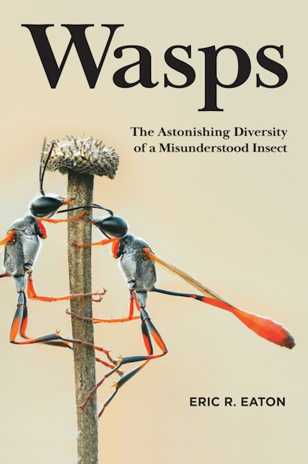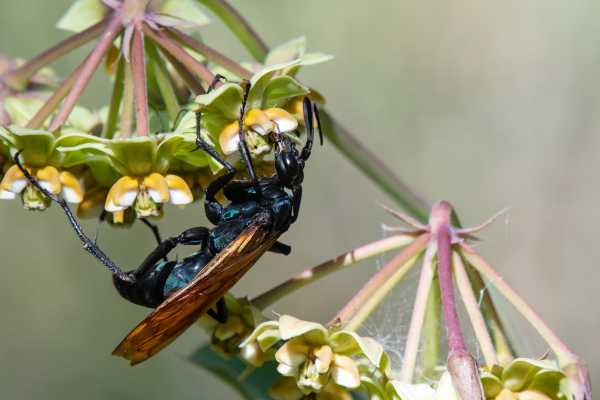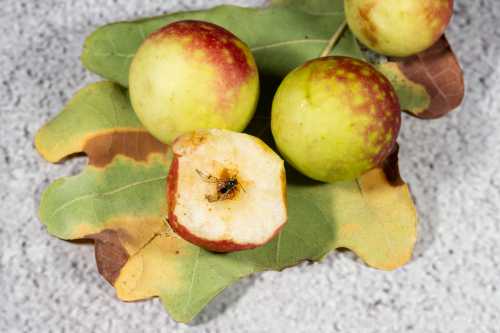Do Wasps Pollinate Flowers?
For many, wasps are seen as a threat and even a nuisance. Increasingly, however, with the spotlight on pollinators generally, people are beginning to ask the question, 'are wasps pollinators?'.
The short answer is 'yes' and scientific research confirms this is the case.
Let us not forget that bees and wasps are related (actually, bees are believed to be descended from wasps - or Vespidae).
Here we provide summaries of a number scientific studies confirming this fact. Not only are wasps useful to gardens for pollination, farmers are increasingly turning to wasps for natural and effective pest control.
Investigating Wasp Pollination
Years ago, I found there were a number of casual myths about wasps, in particular, the notion that wasps have smooth bodies and cannot pollinate flowers.
The truth is, even the Common Wasp (Vespula vulgaris) and German Wasp (Vespula germanica), often the target of pest control companies, do indeed have hairy bodies.
Wasps are helpful pollinators. This is one of the benefits they bring to any garden, in addition to taking crop-eating insects to feed to their young.
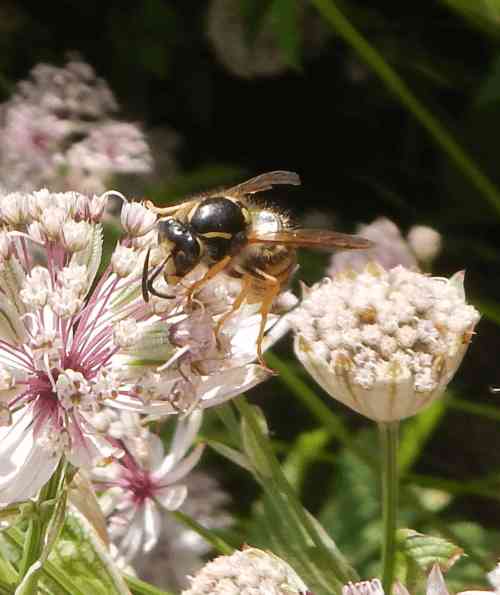
The hairy bodies of wasps
I first examined the hair on a wasp when I found a dead wasp on a window sill of a room that is
only rarely used. The body of the wasp had a fine covering of dust,
which stuck to the hairs, making the hairs themselves more visible.
It is true that some species will be more or less hairy than others (for example, scoliid wasps are especially hairy).
The hair on the black and yellow striped abdomen of many common wasp species is so fine, it
is almost invisible to the naked eye. On close examination, however, it is indeed fine, but dense. Similarly, the thorax of the wasp (upper body) is covered in thick black hairs.
The presence of hairs on the body of the wasp, coupled with the fact that it visits flowers for nectar, persuaded me that pollination was likely, before reading research confirming the fact.
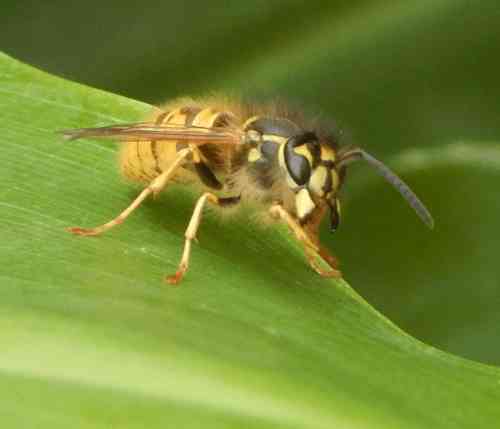 The hairs can clearly be seen on this beautiful wasp.
The hairs can clearly be seen on this beautiful wasp.On a personal note, I remain convinced that wasps assist in the pollination of our autumn raspberries, and believe they were almost entirely responsible for pollinating a cotoneaster tree in my garden in 2011, resulting in an excellent crop of berries for the birds that winter.
Scientific Research Confirms Wasps Are Pollinators
Research into wasp pollination in comparison to that investigating bee pollination is quite limited. I expect this to change in the future.
However, even from the small amount of research information we have, we can prove
that wasps pollinate flowers. In addition:
- There are species of orchid believed to
be pollinated exclusively by particular wasp species
- Wasp pollination is
vital for figs.
Wasp Pollination Research
Brazilian Study
Here is a quote from the abstract:
"This work aimed to verify which wasps act as pollen vectors and can make potential pollination in the community of floral visitors of Schinus terebinthifolius Raddi in Santa Cruz do Sul, Rio Grande do Sul.
On the flowers of one individual, 1619 insects were collected, where 616 belonged to Vespidae. 55,7% of the total of Vespidae presented pollen grains attached to their exoesqueletum confirming the pollinator habit of some species. Polistes versicolor, P. simillimus, Polybia sericea andP. ignobilis presented large quantities of pollen on their body, beyond high values of dominance and constancy, proving its importance on the pollen transportation and potentiality to act as pollinators of the studied taxon."
Wasp Pollination By The Spider Hunting Wasp
There are a number of different species of spider hunting wasp, and they are important pollinators. This paper looks at wasp pollination of plants from the hyacinth family. It showed that floral scent played a role in attracting these pollinating wasps. If wasps pollinate hyacinths, then why not other flowering plants?
Wasp Pollination Of Broad-Leaved Helliborine
How this flower - a type of orchid, tricks the common wasp into a pollinating visit.
German wasps also help to pollinate some species of British orchids. For an example, one article states1:
"Pollination is done by two species of wasp, the German wasp and the tree wasp Dolichovespula sylvestris."
Beetles and wasps and orchid pollination
A further study (from Germany) discusses specialisation for pollination by beetles and wasps and orchid pollination.
Figs And Wasp Pollination
Figs and fig wasps have evolved to help each other out: fig wasps lay
their eggs inside the fruit where the wasp larvae can safely develop,
and in return, the wasps pollinate the figs.
Note: After writing this piece, I came across yet more research, summarized on my page: wasp pollination.
This is just a handful of references on the subject of whether or not wasps pollinate flowers, and yet, the benefits of wasps and wasp pollination are rarely understood.
Harnessing the wider benefit of wasps
Increasingly, farmers, horticulturalists and growers are harnessing the assistance of wasps to help control pests, which may otherwise destroy crops. For example, one of the types of wasps used, is a kind of 'body snatcher wasp'! This means harmful insecticides can be cut out.
The jewel wasp and the ensign wasp help to control populations of pest cockroaches.
Helpful books about wasps
Here are two of my favourite books to promote education about the benefit of wasps.
- With beautiful illustrations, fear can turn to fascination and respect for children: A Wasp Builds a Nest: See Inside a Paper Wasp's Nest and Watch It Grow by Kate Scarborough and Martin Camm.
- For gardeners and naturalists: 'Bees, Wasps, and Ants The Indispensable Role of Hymenoptera in Gardens' by Eric E Grissell
Wasps eating fruit in the garden
I am aware that wasps can cause concern, especially when fruit attracts them to areas where they are not welcome. Added to this, not everyone is keen to share their fruit crop with insects.
As a gardener, I try to adopt a pragmatic approach, and I find it works for me. I have also come to realize that I really do not need to pick every raspberry and plum.
Here are my tips:
- If wasps are on your fruit, keep covered and calm when picking. Use long tongs to gently pick ripe fruit, such as plums.
Using tongs will ensure you are not accidentally stung whilst picking a plum with an unseen wasp inside! - Pick the fruits you need as soon as they are
ripe. Over-ripe fruit is especially attractive to wasps.
- Remove any windfalls you have no intention of eating, to a safe place at the back of the garden - perhaps a compost heap. Be careful, as wasps may be on the underside of the fruit, and not visible from above. Again, use tongs, and where protective clothing.
- If you have a life threatening allergy to wasp stings then it may be best not to pick the fruit yourself. You may be keen to deter wasps from visiting and/or nesting in your garden.
If you found this page helpful or interesting, I'd really be grateful if you would share it with others - if not this page, perhaps another, such as Gardening For Bees.
Thank you so much :) .
